 klaus-michael schneider
klaus-michael schneider
Keywords: colombia | intelegence | bicol | mfo |
Links: FOTW homepage | search | disclaimer and copyright | write us | mirrors

Last modified: 2021-08-26 by  klaus-michael schneider
klaus-michael schneider
Keywords: colombia | intelegence | bicol | mfo |
Links: FOTW homepage |
search |
disclaimer and copyright |
write us |
mirrors
See also:
I had discovered very recently that according to the
legislation in Colombia regarding flags, there is an official War
Flag for almost every official institution, that is, the three
branches of government (Executive, Legislative, Judicial) at
almost all levels (National, Regional, Municipal).
I have come to the conclusion after searching for official flags
and found out that most of the times there are two official
flags: Bandera de Guerra (War Flag), which is the Colombian
tricolor, with the motto REPUBLICA DE COLOMBIA on top, and the
corresponding institution's name on the bottom and sometimes the
"additional official flag" or more precisly, the
Estandarte (Standard).
Decree No. 861 of 1934 (May 17) describes the War Flags on
Article 3. The dimensions mentioned there on this same article,
are for the Army flag, but they are the foundation for all other
flag legislation onwards. However, there is a slight difference
according to current dimensions of flags. On Article 3 of the
previously mentioned Decree, says that "...will be 1.30
meters long, by 1.10 meters wide...", but there is an
ammendment by Decree No. 62 of 1934 (January 11) that says that
the actual specifications are "...1.35 meterslong by 1.10
wide...".
The "the latest legislation on the use of the Flag, Coat of
Arms and National Anthem is online at the Colombian
Ministry of Communications website. In Article No. 8 of this
Decree it says that the Bandera Nacional (National Flag), the
official name of the Colombian flag, can only be used with the
Coat of Arms by the President and the Armed Forces, being called
Bandera de Guerra (War Flag). Then on Article No. 12 it says that
the Coat of Arms can be used in the Bandera Nacional del
Presidente de La República (President of the Republic National
Flag), War Flags, and official documentation.
Thus, the name that appears as "official flag" is
actually Bandera de Guerra (War Flag) and the name
"additional official flag" is actually Estandarte
(Standard).
E.R., 25 August 2008
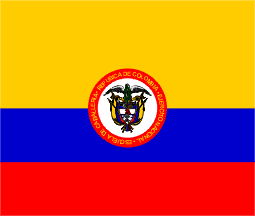 (~4:5)
(~4:5)
image by Željko Heimer, 17 May 2001
Ratio ~4:5. Adopted: 17 May 1924. In use except small changes
of the shield. In the red circle the name of the army unit that
is using it should be written .
Jaume Ollé, 25 July 1996
This flag and the Cavalry Flag are my
"reconstruction" with what I think is reasonable to
expect what's written on the red ring, exaple for a mounted unit
and example for the Army (assuming that the army as whole would
have the infantry version of the colours). The image is based on
site <www.escaballeria.mil.co>.
There are few photos of the flag there but non good enough to
provide for the text. I was not able to find an other infantry
unit, so the Cavalry Flag image is maybe a
streching a bit too far.
Željko Heimer, 17 May 2001
Article 3 - the war flag used by the Army is one meter and
thirty centimeters long and one meter and ten centimeters wide
for the units on foot and the standard for the mounted units
should be one meter long and one meter wide. These flags shall
have in the center the coat of arms of the Republic surrounded
with a ring of red (velvet?) five centimeters wide and forty
centimeters of the outer diameter in which is inscribed in golden
letters the name of the unit to which it belongs.
Decree Nr. 62 of 1934 (January 11) - 208. The war flag used by
the Army shall be, in accordance to the law, one meter and thirty
five centimeters long and one meter and ten centimeters wide, for
the mounted units. This flag shall have in the center the coat of
arms of the Republic, set in an oval of red cloth on which shall
be inscribed, in letters outlined in gold the name of the unit or
military division to which it belings.
209. The flag with the coat of arms shall only be used by the
armed forces of the Nation.
Željko Heimer, 17 May 2001
The military flag (a.k.a war flag) can be seen in a photo showing Colombia's
Foreign Minister, Fernando Araujo, left, shakes hands with U.S.
Deputy Secretary of State John D. Negroponte in Bogota, Tuesday,
May 8, 2007.
Ivan Sarajcic, 9 May 2007
Variants (?)

image by Jaume Ollé, 27 October 2001
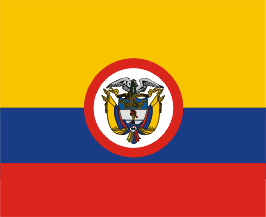
image by Jaume Ollé, 27 October 2001
Military flag as legislate and as it is. Naval ensign,
military flag and cavalry standart was kept without change by
resolutions 64 (9-1-1961) and 4235 (1965) and still in use.
Jaume Ollé, 27 October 2001
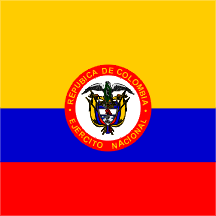 (1:1)
(1:1)
image by Željko Heimer, 17 May 2001
Ratio 1:1. Adopted: 17 May 1924. In use except small changes
of the shield.
Jaume Ollé, 25 July 1996
Variants (?)
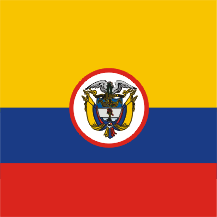
image by Jaume Ollé, 27 October 2001
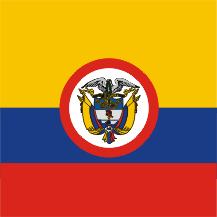
image by Jaume Ollé, 27 October 2001
Cavalry standart as legislate and as it is used. Naval ensign,
military flag and cavalry standart was kept without change by
resolutions 64 (9-1-1961) and 4235 (1965) and still in use.
Jaume Ollé, 27 October 2001
The Cavalry Flag is not really a flag. It is merely the
Colombian flag with a sumperimposed shield. I have seen this
symbol many times in armored units of the Army in Bogota (Capital
of Colombia). What the shield reads is: "Republica de
Colombia - Ejercito Nacional - Escuela de Caballeria". The
"Escuela de Caballeria" is actually a training facility
located in Bogota to train the soldiers and officers in charge of
the armored units of the Army. You can also find several
"Caballeria" facilities troughout the country as they
are used on a permanent basis to support ground troops that
engage in combat.
Jorge Eduardo Alonso, 8 June 2002
Army (EJC)
image by Carlos Thompson, 2 June 2003
Navy (ARC)
image by Carlos Thompson, 2 June 2003

Air Force (FAC)
image by Carlos Thompson, 2 June 2003
In the front dor of the Military Hospital, in Bogotá,
Colombia, there are three flags in plain color: dark blue, light
blue and red. I supose that the flags are just versions without
the coat of arms, of the flags of the Army (EJC), Navy (ARC) and
Air Force (FAC). I have also seen the red flag at the Cadet
School, in Bogota.
Carlos Thompson, 2 June 2003
António Martins wrote: "These seem to follow
the british pattern...". Given that Colombia military
airfield flag follows a British pattern: sky blue flag with
national flag in the canton and roundel in the fly; and that
Britain had a lot of influence in Latin America post
independence, that would be a fair guess.
Carlos Thompson, 3 June 2003
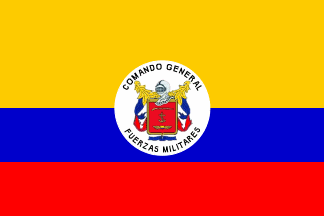
War Flag
image by Eugene Ipavec, 26 December 2004
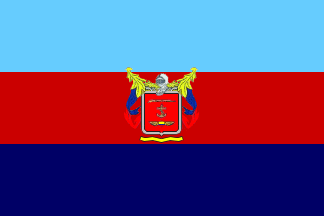
Standard - obverse
image by Eugene Ipavec, 15 February 2006
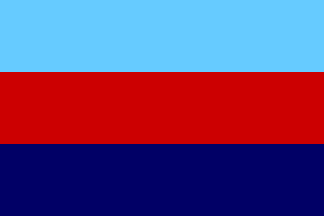
Standard - reverse
image by Eugene Ipavec, 15 February 2006 (based on
original by Jaumé Ollé)
Comando General de las Fuerzas Militares - Colombia (General
Command of Military Forces) - This flag can be seen (in an arty,
animated way), at the frame "organizacion" at <www.mindefensa.gov.co>.
Guillermo Tell, 3 June 2000
Website at <www.cgfm.mil.co>.
The flag is divided into three horizontal equal stripes, with
light blue (top), red (middle) and dark blue (bottom). The CGFM
(for its initials) was created by Decree No. 835 of April 16,1951
and its in charge of the Planinng and Strategic guidelines of the
Colombian Armed Forces.
I would also like to mention that the colors of this flag are the
same (only inverted) to the flag of
British Joint services, so probably the Colombian military
use this flag to design their own. The colors on the Colombian
CGFM flag are light blue on top (airforce), red on the middle
(ground forces) and dark blue on the bottom (navy).
E.R., 25 July 2005
However, in the shield at the center of the arms the symbols
of the services are, top to bottom, Army (rifle), Navy (anchor)
and Air Force (winged mini-shield). Perhaps they were placed in
order of seniority.
Eugene Ipavec, 26 July 2005
This is correct: The symbols displayed (from top to bottom)
are indeed in order of seniority. The Army was the first Force
(its foundation date is considered 1819, the year the Battle of
Boyaca was fought and Colombia gained its independence from
Spain). The second Force was the Navy (its foundation date is
considered to be 1824, the year the Naval Battle of Maracaibo was
fought, defeating the whole Spanish domain in the South American
territory, except for minor engagements that took place inland in
1825). The last Force created was the Air Force (its foundation
date is considered to be 1919, when Colombian President Marco
Fidél Suárez established the Air Arm, as a Branch of the Army).
E.R., 26 July 2005
All military flags in Colombia have one version in tricolour
flag and the other one with the Coat of Arms and background
colors. Sources for the first version are <www.cgfm.mil.co> and <www.mindefensa.gov.co>.
E.R., 26 December 2004
The color composition of additional official flag is as
follows: Light blue on top, which represents the Air Force, and
should be the same shade as the Air Force plain flag. Red in the
middle, which represents the Land Force (Army), and should be the
same shade as the Army plain flag. Dark blue on bottom, which
represents the Sea Force (Navy), and should be the same shade as
the Navy plain flag. In the obverse it has the coat of arms and
on the reverse it is plain.
E.R., 28 January 2006
The organizational chart of the General Command of Military
Forces is seen here.
The previous organizational chart is based on Resolución No.
0606 of 2005 of the Ministry of National Defense and Disposición
No. 018 of 2005 the CGFM.
E.R., 10 August 2009
Variant
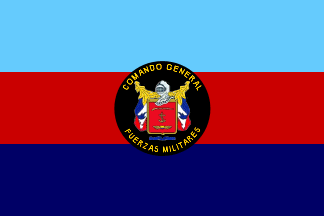
image by Eugene Ipavec, 2 January 2008
This is a variant of the CGFM flag. The variant is the Coat of
Arms which is encircled on a black disc, the letters are in
yellow and the flag has a yellow embroided border. The source is
a photo taken on Colombia Independence Day, July 20, 2006.
E.R., 2 January 2008
Cravats
On March 19, 2009 on the official website of the General Command of Military
Forces, a picture appears showing the General Command of Military Forces Flag
(variant) with a streamer of the same colors.
Image is a screenshot of the official website of the
General Command of Military Forces
taken on March 19, 2009. It is a cravat
rather than a streamer.
Esteban Rivera, 2 September 2010
The Estado Mayor Conjunto (Joint Chiefs of Staff) is below the
General Command of Military Forces Flag in the hierarchy of flags
on the iIlitary Flags section. This post is held by the Segundo
Comandante y Jefe de Estado Mayor Conjunto (Vice Commander and
Chief of the Joint Chiefs of Staff) and it is in charge of the
Command functions delegated by the government, becoming a virtual
Commander General.
Source: <www.cgfm.mil.co>.
The War Flag (Colombian Tricolor with the respective country's
Coat of Arms, plus the legend REPUBLICA DE COLOMBIA on top in
bold capital golden lettering) has the words ESTADO MAYOR
CONJUNTO on the bottom in bold capital golden letters. Picture
can be seen here.
The original article dates back to August 15, 2006 published on
the official
website of the Colombian Presidency.
E.R., 10 August 2009
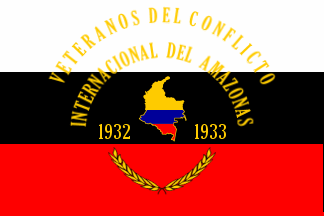
image by Eugene Ipavec, 12 March 2009
The flag of Colombian Amazon Conflict Veterans is located at:
the online official
website of the Military Forces General Command.
The Colombian Amazone Conflict refers to an armed border dispute
between Colombia and Peru, between 1932 and 1933. For further
reference please see: wikipedia.
It is a rectangular flag, horizontally divided into three equal
stripes, top white, middle black and bottom red. My best guess is
that the inscription in golden capital letters is
VETERANOS DEL CONFLICTO
INTERNACIONAL DEL AMAZONAS
1932 1933
Between the dates "1932" and "1933" there is
a map of Colombia in yellow (50%) on top, blue (25%) on the
middle and red (25%) on the bottom. There is also a pair of
crossed boughs in the lower stripe.
E.R., 12 March 2009
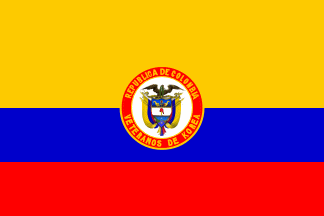
obverse
image by Eugene Ipavec, 8 December 2005

reverse
image by Eugene Ipavec, 10 March 2006
This is the official flag of the Korean War Veterans from
Colombia. It is the same as the AFEAU
flag, only that on the bottom fringe it reads "VETERANOS DE
KOREA" (Please notice that Korea is spelled in English,
because in Spanish it is Corea, but somehow they put it in
English). The picture was taken from the website of the Ministry
of National Defense (<www.mindefensa.gov.co>)
durign the 50th anniversary of the participation of troops from
Colombia in the Korean War, under the US command leading the
UN-forces. In the picture are the former Minister of Defense and
the former Commander General of the Military Forces back in an
award ceremony in 2002.
E.R., 8 December 2005

obverse
image by Eugene Ipavec,
On February 24 of 2008, I went to a military fair held in one
of the newest shopping malls built recently in Medellin. There
they had military equipment and gear, as well as videos, weapons.
It was attended by present active, retired, reserve and veteran
military personnel.
I found the banner of ASVEGIC (Asociación de Veteranos de la
Guerra Internacional de Corea, Association of Veterans of
the International Korean War)
It is on red background, charged with the lion of the Coat of
atms of the Batallón Colombia
with the yellow letters ASVEGIC on top.
E.R., 30 March 2008
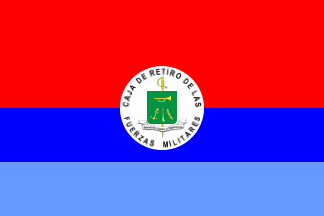
Standard
image by Eugene Ipavec, 10 August 2009
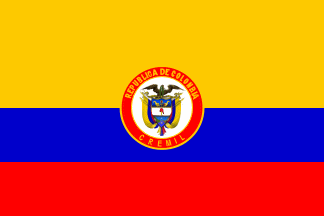
war flag
image by Eugene Ipavec, 10 August 2009
.gif)
coat of arms
image by Eugene Ipavec, 30 July 2006
The Standard of the Caja de Retiro de las Fuerzas Militares
(Military Forces Retirement Fund). The abbreviation in Spanish is
CREMIL. It is the organization in charge of pension related
issues of the Military Forces. The Standard has the same
proportion in as the Colombian flag, that is 50% of the flag is
one color (in this case red, representing the Army), and the
other 50% is divided into two; 25% of dark blue representing the
Navy) and the other 25% in light blue (representing the Air
Force).
The motto on the Coat of Arms is "SERVICIO JUSTO Y
OPORTUNO". Tha Standard has the Coat of Arms on a white
circle added to the above mentioned flag. However the black
letters that appear on the flag itself I cannot identify.
Source: Official
CREMIL website.
E.R., 30 July 2006
I have found an article
on their official website showing the flag in a better
resolution. Notice that the black letters around the Coat of Arms
are simply the name of the institution. On the top it reads
"CAJA DE RETIRO DE LAS", and on the bottom it reads
"FUERZAS MILITARES".
In the same article, one can see the war flag of the CREMIL on
the left hand side of the picture, which is the Colombian
tricolour and on the top of the Colombian Coat of Arms it reads
REPUBLICA DE COLOMBIA and on the bottom it reads CREMIL, both in
golden letters.
E.R., 10 August 2009
CORASA (Corporación Reserva Activa y Sociedades Aliadas) (Active Reserve
Corporation and Allied Societies) is a non-profit organization which seeks to
strengthen the dignity of the active reserve and to promote a better life
quality standards through housing, courses, employment and entrepreneurship.
Source:
http://www.corasa.org/nosotros.aspx
The flag can be seen
here
(picture taken on August 20, 2010 during an awarding ceremony, by the General
Commander of Military Forces).
Esteban Rivera, 11 September 2010
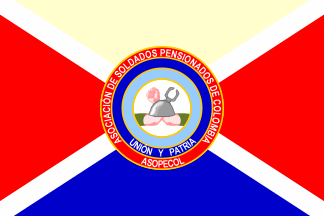
image by Eugene Ipavec, 14 June 2011
The flag is a horizontal flag, with a white diagonal cross, white on top, red
on both sides and blue on the bottom, plus the logo. The logo has three
concentric circles, light blue, blue and red representing the members of the
Armed Forces, plus the motto which is on silver capital letters "UNIÓN Y PATRIA"
(Union and Fatherland). On the red concenctric circle, it reads the name of
the association on top in silver letters, "ASOCIACIÓN DE SOLDADOS PENSIONADOS DE
COLOMBIA", and on the bottom the initials of the Association, "ASOPECOL", in
silver capital letters as well.
Esteban Rivera, 24 August 2010
The picture of the flag is found
here. To me the logo in the middle looks like two arms turning into a 45°
angle wearing olive green uniform sleeves, the hand on the left being a closed
fist, and the hand on the right having a steel arm prosthetic, much like the one
seen in this
picture (left hand), both arms surpassing a steel helmet in the
middle.
Esteban Rivera, 14 June 2011
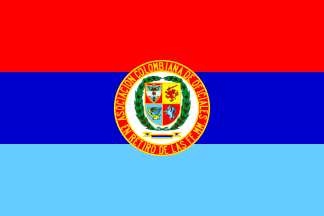
image by Eugene Ipavec, 27 October 2010
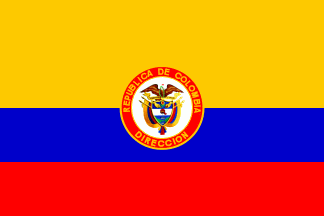
image by Eugene Ipavec, 27 October 2010
acore.gif)
image by Eugene Ipavec, 27 October 2010
There's a Veterans organization called ACORE (Aosciación Colombiana de Oficiales en Retiro de las Fuerzas Militares, in English Colombian Association of Retired Officers of the Military Forces). It was established on November 25, 1960 for the purpose of gathering retired officers in ther day-to-day activities as "civilians".
The flag has the same color pattern as the General Command of Military Forces Flag -
Standard, only the colors are in a different order (red on top, dark blue in the middle and light blue on the bottom) maybe meaning that the Army was the first being established, then the Navy and the last one was the Air Force. The flag has the ACORE
CoA in the middle. The flag is seen
here.
Also the Dirección (Directorate) has a flag as well, which would be a War Flag (Colombian tricolor, with the CoA on it, with the lettering DIRECCION on the bottom fringe), as seen
here.
The organizational chart is here:
http://acore.org.co/principal/archipdf/cargos_personal.pdf
Esteban Rivera, 31 Augusr 2009
The ACORE (Asociación Colombiana de Oficiales en Retiro de las Fuerzas
Militares) (Colombian Association of Military Forces' Retired Officers) was
established on November 25, 1960, as the Asociación Colombiana de Oficiales en
Retiro del Ejército (Colombian Association of Army Retired Officers), then it
included all retired Officers from all the other forces (Navy and Air Force).
Source:
http://acore.org.co/principal/index.php?option=com_content&task=view&id=17&Itemid=33
The ACORE flag is seen
here.
It is horizontally divided into three equal stripes having a similar color
configuration as the CGFM Standard, the only difference being
the order of the colors. ACORE's flag has red (top), navy blue (middle) and
light blue, each color standing for the respective force's
color. In the middle is the Coat of Arms of ACORE, which can be seen
here.
The motto below the Coat of Arms reads PATRIA * UNION * PROGRESO (Fatherland,
Union, Progress) in white capital letters, as seen
here.
For additional information please see: ACORE
(Official website).
Esteban Rivera, 19 September 2010
The FECODEMIL (Federación Colombiana Deportiva Militar) (Colombian Military
Sports Federation) was established by Decree No. 3938 of December 27, 1950 as
the "Dirección General de Educación Física y Deportes Militares" (Physical
Education and Military Sports General Directorate) and it was affiliated to the
CISM August 29, 2002 in Brussels,
as the 123rd Federation.
Source:
http://www.cgfm.mil.co/CGFMPortal/index.jsp?option=contentDisplay&idCont=830
The flag is a white horizontal background, with the
logo in the middle, as seen on this
picture
(fourth flag, from left to right)
Source: http://190.60.108.210/webensb/book/export/html/135
Official website:
http://www.cgfm.mil.co/CGFMPortal/index.jsp?option=contentDisplay&idCont=50
Esteban Rivera, 31 January 2011
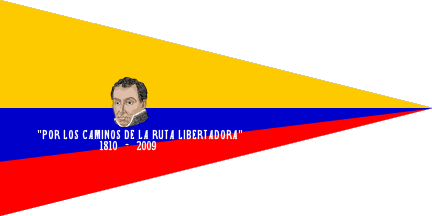
image by Eugene Ipavec, 12 August 2009
A reenactment of the Ruta Libertadora (Freeing Route,
the final military campaign that established Colombian full
independence from Spain in 1819. although several battles were
fought later on, official website at <web.presidencia.gov.co)
was established to take place from July 20, to August 7 of 2009
to commemorate the 190 years of this campaign. This reenactment
is part of a series of events leading up to the Bicentennial of
Colombia's independence.
During the celebration of the Army Day, held on August 7 as a
commemoration of the Battle of Boyaca (August 7, 1819) that gave
Colombia its total independence, a pennant has been spotted at
<www.mindefensa.gov.co>.
Looking at an unnofficial
website of the Military Forces of Colombia, I found a better
picture for this Pennant.
It seems to be the official Pennant of the Ruta Libertadora,
as the flag displays a color silouette of General Bolívar's
bust, and below him in small capital white letters it reads:
"POR LOS CAMINOS DE LA RUTA LIBERTADORA" 1810-2009
It is a tricolor pennant, following the same pattern of
the General Commanding a Military
Unit Pennant.
E.R., 10 August 2009
There is also a cloud of words around his head - battles?
Eugene Ipavec, 12 August 2009